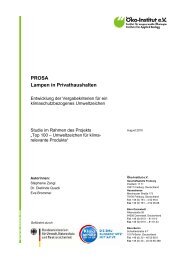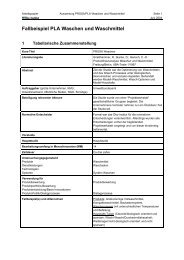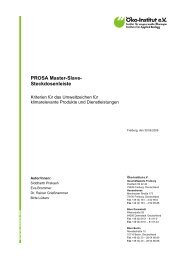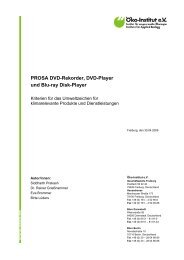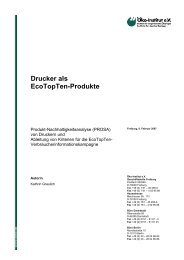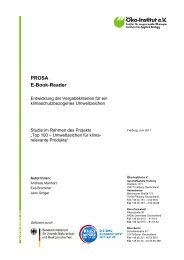PROSA – Product Sustainability Assessment - PROSA - Produkt ...
PROSA – Product Sustainability Assessment - PROSA - Produkt ...
PROSA – Product Sustainability Assessment - PROSA - Produkt ...
Erfolgreiche ePaper selbst erstellen
Machen Sie aus Ihren PDF Publikationen ein blätterbares Flipbook mit unserer einzigartigen Google optimierten e-Paper Software.
<strong>PROSA</strong> <strong>Product</strong> <strong>Sustainability</strong> <strong>Assessment</strong><br />
10.7.3 Qualitative versus quantitative Indicators<br />
There is a general discussion to use mostly quantitative inventory data for social LCA or to<br />
focus more on qualitative data and indicators 52 . Quantitative data are those expressed in<br />
numbers and qualitative data are those expressed in words. The Taskforce took side for a<br />
combination of quantitative and qualitative data, indicators and analysis. It voiced the<br />
opinion, that quantitative data and indicators alone are insufficient to cover all aspects of<br />
social impacts. On the other hand, one has the possibility to "translate" qualitative results into<br />
(semi-)quantitative results as suggested by Benoit and Dreyer 53 . The aim is to produce the<br />
most accurate and relevant assessment possible. But even in the phase of interpretation one<br />
can work with quantitative results in parallel with qualitative results.<br />
10.7.4 The complexity behind social indicators and the need of clear definitions<br />
Most indicator-lists mask the complexity of the individual topics. A good example is the topic<br />
child labour. One would think that it may be easy to define child labour with one thresholdage<br />
globally. But looking at only one of the relevant ILO-Conventions <strong>–</strong> the ILO Minimum Age<br />
Convention No. 138 <strong>–</strong> one finds a whole set of possible threshold-ages for different kinds of<br />
work and for different economic situations:<br />
The general minimum age for admission to employment or work is 15 years (13 for light<br />
work) and the minimum age for hazardous work 18 years (16 under certain strict conditions).<br />
Additionally there is the possibility of initially setting the general minimum age at 14 (12 for<br />
light work) in regions where the economy and educational facilities are insufficiently<br />
developed. Furthermore the ILO Worst Forms of Child Labour Convention No. 182 adds<br />
another threshold age of 18 years.<br />
During the process of collecting and sorting social indicators, one meets the problem that<br />
indicators are often tailor-made for very specific purposes: Almost all indicators set their<br />
focus on evaluating the differences between products and enterprises in one specific<br />
economic, social and political environment. In some democratically structured and<br />
industrialized countries differences between products and companies may be measured with<br />
indicators like the length of the annually paid holiday or the possibility for alternative working<br />
models like telecommuting, job-sharing etc. Other indicators focus on social aspects that<br />
central european workers take for granted since many decades. This includes indicators on<br />
child labour, human rights abuses, or the right for workers to enjoy at least one 24-houres<br />
52<br />
53<br />
Examples of qualitative indicators are languages spoken in the company or corruption or transparency.<br />
see in detail: Rainer Griesshammer, Andreas Manhart, Louise Dreyer and Anna Flysjö, "Developing a Set of<br />
Indicators for a Social LCA", November 2005.<br />
155



